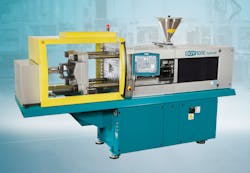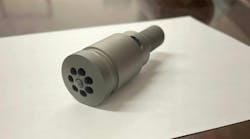Injection molders looking to marry hydraulic and electric operations found the best of both worlds at K 2019, where a number of machine makers demonstrated or announced new or updated hybrid models. The companies include Wilmington Machinery, Dr. Boy GmbH & Co. KG, Wittmann Battenfeld, Haitian and Bole Machinery.
Wilmington Machinery
Wilmington Machinery is now offering the Lumina MP800R, a redesign of its Lumina MP800. The new medium-pressure injection molding machine offers greater extrusion capacity, greater shot capacity and a higher injection pressure, Wilmington Machinery President Russ La Belle said. Also, the extruder is now electrically driven instead of hydraulically driven.
“The benefit of these changes is that you can now do much thinner wall molding,” La Belle said. “This opens up opportunities in lots of markets, including automotive, material handling and recreational.”
The Lumina MP800R is an 800-ton, general-purpose injection molding machine that is designed for making large products. It has a shot capacity of 50 pounds, and an external platen that is 7.5 feet by 7 feet by 1.2 feet. The tie-bar clearance is 5 feet by 4.6 feet.
“You can put in some very large parts or use multiple cavities,” La Belle said. “It can be a multi-part machine.”
It also is capable of molding foamed products.
“It is something of a specialty general-purpose machine,” La Belle said. “It is general-purpose because it is versatile for many industries. It also offers direct gas injection into the barrel. It is a foam injection machine with physical foaming agents, including nitrogen or carbon dioxide for direct gas injection. It also can be used with chemical foaming agents, which tend to be more expensive.”
After the resin is completely melted in the barrel, gas is injected.
“We have a separate mixer that mixes the gas with the plastic,” La Belle said. “The gas is injected by high-pressure pumping or compressing, depending on the gas. By doing that, it makes the melt flow better into the mold and also gives you density reduction in the product for thinner-walled parts. ... Once you have gas in the material, the plastic flows easily into the mold. The presence of gas allows it to flow into the mold at much lower pressure. Gas makes a big difference in flow rate.”
The company re-engineered the injection unit on the Lumina MP800R to incorporate an in-line accumulator and a reciprocating screw with an L:D ratio of 30:1. A previous model had an accumulator next to the extruder. The new design and the reciprocating screw allow users to compound both virgin and recycled resins with various fibrous and non-fibrous additives for strength, which reduces the cost of the molded component.
“This gives you the capability of doing a superb job of melting recycled materials or of compounding in additives that enhance the properties of materials without having to buy expensive compounded resins,” La Belle said.
The Lumina MP800R features power grip clamping, which is designed for fast press speeds and excellent force distribution.
“This is a technology that was developed by a German company,” La Belle said. “Instead of having a big hydraulic cylinder that is pushing the platen closed, you have a very small hydraulic cylinder to move the platens. You also have four power grip devices that grip the tie bars and apply force. Each of them develops 200 tons, so on a four-tie-bar machine that is 800 tons total. The devices apply the force from four corners, so you have a better force distribution than when you push from the middle.”
Although it is a medium-pressure machine, the MP800R can accommodate hot-runner molds in addition to cold-runner molds, which is a feature often found only on high-pressure machines.
“Hot-runner molds lend themselves to stack molds, which is an emerging mold construction technique,” La Belle said. “In a stack mold, you can hold two cavities stacked one on top of the other. The molds close with the same force, so you can do twice the molding and get two parts instead of one.”
The Lumina MP800R is available for purchase now, La Belle said. It will be installed in the lab at Wilmington Machinery in the second or third quarter of this year.
Dr. Boy
Dr. Boy, Neustadt-Fernthal, Germany, introduced a new injection unit, known as the eSP servo-plast unit, that has servo-electric drives, which offers a new level of hybrid functionality to its medium-size IMMs. The unit has two servo motors that operate independently of the machine hydraulics to drive the injection and metering movements.
The hybrid machines can produce parts more quickly than hydraulic machines and handle larger shot sizes than all-electrics, the company said. Hydraulics control the Boy machines’ clamping unit. The injection unit size on the machines is 170.
“When you open the clamp on the hybrid machine, you can do screw recovery at the same time, which reduces cycle time,” said Marko Koorneef, the president of Boy Machines, the U.S. business unit of Dr. Boy. “With the double-pump hybrid, you can do both at once, unlike hydraulic machines.”
The injection and screw rotation on machines supplied without the eSP unit are hydraulically, rather than electrically, powered. In contrast, Koorneef said, “The 100 E [at] the K show was equipped with electric injection and electric screw rotation and not hydraulic.”
The Boy 100 E hybrid on display at K 2019 manufactured pharmaceutical measuring cups on an eight-cavity mold. The cups were transported by an encapsulated conveyor belt to a bag-packaging machine.
The press can be equipped with Boy’s LR 5 top-entry robot to add automation without expanding the footprint.
Wittmann Battenfeld
Wittmann has expanded its line of VPower R vertical IMMs by adding 220-ton and 300-ton units to the machine lineup, which now ranges from 120 tons to 300 tons. In VPower machines the injection unit can be placed in a vertical or horizontal position. The machines feature two tie bars and a rotary table.
All VPower machines are available with the Combimould option, which means that two resins with different attributes or colors can be molded into one part without removing the part from the machine.
The rotary table clamping unit on the VPower machines has no central tie bar. Instead, the servo-driven rotary table combines with a two-tie-bar portal clamping unit that’s equipped with two traveling cylinders that are on the outside of the table.
The clamping unit is designed to be rigid and lightweight. Wittmann’s Uniforce compensation plate system between the horizontal beams and the mold clamping area provides an even and gentle force to the mold, the company said. This design minimizes excessive force, which can cause deformation.
VPower rotary tables are available in diameters of 4.3 feet, 5.2 feet and 6.6 feet. The 220-ton machine can use a 5.2-foot or 6.6-foot rotary table, while the 300-ton machine uses the 6.6-foot rotary table.
The rotary tables are powered by servo-electric drives designed to provide quick rotation times and precise positioning. A central lubrication system for all rotary table moving parts is designed to improve operator safety. The circumference of the rotary table is sealed to prevent liquids or particles from penetrating inside the table.
The rotary tables can accommodate either an oscillating two-station operation; or a rotating two-, three- or four-station operation.
Because there is no central tie bar, there is space to install connections for water, hydraulic oil, compressed air and power under the rotary table. Tubing or an oscillating or rotary distributor can lead connections to the molds through the center of the rotary table, the company said.
The machine’s open design allows space for automation systems, such as a robot for finished parts removal.
Haitian
Haitian has updated its Jenius series of hybrid injection molding machines with the Jenius III, which features a new injection unit. The machine is part of the company’s Third Generation Technology introduced at K 2019, which included new electric machines, the Venus III and Zeres III, and the new hydraulic Mars III. The Jenius III will be available in the U.S. and Canada in the second half of this year, the company said.
“Features of the units include precise repeatability and injection speeds of up to 500mm per second,” said Mike Ortolano, co-owner and CTO of Absolute Haitian.
The units are available in one-, two- and four-spindle versions. Units with greater numbers of spindles can better accommodate larger shot sizes and parts, Ortolano said. Depending on the size of the clamp, users can select from between one and five different injection unit sizes.
The one-spindle version is compact, with the spindle and screw arranged in a line. It is designed for precision and efficiency and can be used on injection unit sizes ranging from 50 to 1,700.
The two-spindle version features synchronous servo motors and symmetrical injection for correcting carriage movement deviations. It is designed to maintain parallelism to prevent premature wear on the injection unit. Two-spindle injection units are available in sizes ranging from 2,250 to 9,200. The two-spindle design is available on the Jenius 5500 III through Jenius 18500 III, which have clamping forces ranging from 618 tons to 2,079 tons, respectively.
The four-spindle injection units feature multi-axis control technology based on servo-torque direct drives. Algorithms enable the precise synchronization of all drives to allow for a fast response time. They are available with injection units ranging from 12,800 to 22,800. These injection unit sizes are available on the Jenius 18500 III through Jenius 33000 III, which have clamping forces of 2,079 tons through 3,709 tons, respectively.
Bole
Bole is now offering its FE series of fully electric machines with an embedded hydraulic pump station at no additional cost. The cylinders are all contained within the machine, so there is no side pump station to take up additional floor space.
He said the company can do this due to its manufacturing process.
“At the end of the final assembly of the product, we decide — according to the customer’s wishes — if it will be built as a hybrid or a fully electric version,” Rak said. “We will follow this path so the customer will always have this option. I have not seen many other companies offering this at the same price point. Nor have I seen them offer it with the hydraulics cleverly embedded inside the machine. That unit normally takes up space outside the machine, where it can get in the way of forklifts and other operations.”
The FE series is available in North America with clamping forces ranging from 121 tons to 386 tons. Rak said the company has machines in stock in the U.S. that are ready to ship.
Contact:
Absolute Haitian Corp., Parma, Ohio, 216-452-1000, www.absolutehaitian.com
Bole Machinery Inc., Stow, Ohio, 330-983-4700, www.boleamerica.com
Boy Machines Inc., Exton, Pa., 610-363-9121, www.boymachines.com
Wilmington Machinery Inc., Wilmington, N.C., 910-452-5090, www.wilmingtonmachinery.com
Wittmann Battenfeld Inc., Torrington, Conn., 860-496-9603, www.wittmann-group.com









